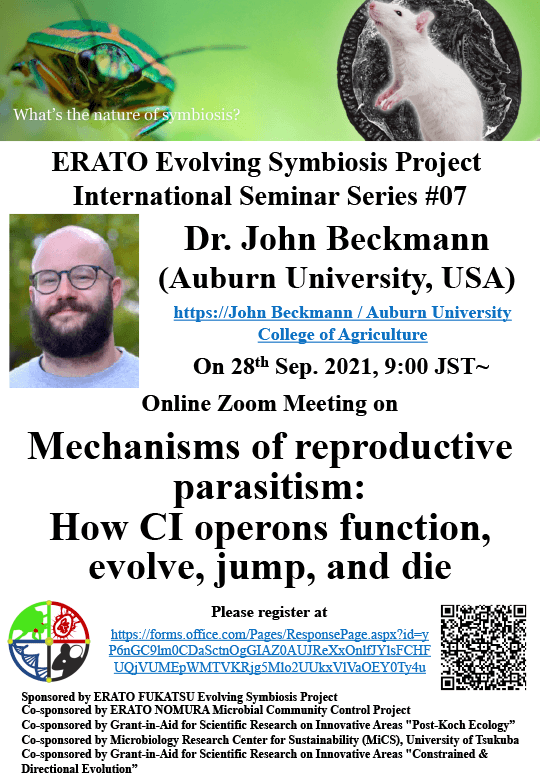第7回共生進化機構国際セミナー(共催)のお知らせ(2021/09/28)
本領域が共催する共生進化機構国際セミナーの開催をご案内します。皆様の積極的なご参加をお待ちしています。
第7回目となる今回のセミナーでは共生細菌ボルバキアによる細胞質不和合の分子機構を世界に先駆けて解明した Dr. John Beckmann (Auburn University, USA)にご講演いただきます。
参加希望者は以下より登録ください。必要情報をお知らせいたします。
https://www.jst.go.jp/erato/fukatsu/news/2021/210928.html
Date: 28 September 2021 9:00 (JST)-
Platform: Zoom Meeting
Lecturer: Dr. John Beckmann(Auburn University, USA)
Title: Mechanisms of reproductive parasitism: How CI operons function, evolve, jump, and die
Abstract: Wolbachia are obligate intracellular bacteria. They are the most common known insect endosymbiont. One cause of their abundance is reproductive manipulation. Wolbachia cause cytoplasmic incompatibility (CI). The CI phenotype was first observed in the 1930ʼs and characterized in the 1960ʼs. Recent discoveries have identified two gene operons that induce CI. The operons behave as a toxin antidote (TA) systems. The toxin has either deubiquitylating or nuclease enzymatic domains that induce the CI phenotype; in some cases both enzyme domains are present. Recent proteomic studies have identified nuclear import factors (karyopherins) and protamine histone exchange chaperones (P32) as target substrates. The operons that induce CI have also been found in close sister bacteria Rickettsia and Orientia. In Rickettsia the operons appear on plasmids which suggests that CI evolved from a simple plasmid TA system. Furthermore, the operons are capable of horizontal gene transfer and have recently “jumped” into pathogenic Orientia tsutsugamushi. The Orientia operon is active when tested in transgenic Drosophila models. Notably, Trombiculid mite vectors exhibit Orientia dependent parthenogenesis. This observation suggests a new hypothesis that parthenogenesis induction and CI might share a common mechanistic foundation, built upon these operons. Finally, evolutionary theory predicts that selection does not maintain these operons, once fixed in a population. However, they persist in nature by “jumping” to new organisms. Operons that do not jump eventually psuedogenize by N-terminal deletions in the toxin gene and/or mutations reducing toxin enzymatic efficiency.

